It’s odd, but before I came to Jordan I had no knowledge of the beautiful semi-tropical canyons and verdant palm expanses of the Dead Sea basin that are known as ‘wadis.’ A wadi, which is Arabic for ‘valley’ can be used for naming the famous Wadi Rum that is one of the prime tourist camping sites, but is used more frequently for the numerous warm rivers and springs that slowly meander their way through the sandstone crags of the mountains that descend towards the lowest point on Earth.
After the fun three-day camping experience that we had in Wadi Hasa several months ago, I’ve been anxious to get back out there again to see more of Jordan’s wadis before departing. Most of my friends that were present for that hike have since departed back to America, but Nelle and Jeff were happy to indulge my entreaties for a hike, and two weekends ago Nelle selected Wadi Himara from her dog-eared and water-smudged wadi guidebook.
Wadi Himara
Wadi Himara means “Valley of the female donkey,” but its claim to fame doesn’t tend towards braying asses but instead to the massive 80 meter waterfall that crowns the end of the journey. I couldn’t find any pictures of the waterfall online prior to the hike, but Nelle assured us that friends of hers had hiked it last year. With the addition of Liam, an English friend of a choir friend, our band of four was complete, and we started off early on Sunday morning from Amman in Nelle’s rented car.
Like my visit to the neighboring Wadi Zarqa’ Ma’in in late June with my Arab friends, we had some difficulty determining which one of the yawning, unmarked canyon entrances that strew the coastline of the shimmering Dead Sea was the one we wanted. Thankfully we had Nelle’s guidance and descriptions to assist us, and we even found a fairly wide shoulder to park the car on before leaping over the bridge wall and tumbling into the scrub brush of the wadi below us. Thick concrete shield pillars greeted us only a few meters in, with entire trees splintered and crushed into their gray teeth – a testament to the sheer awesome force of the floods these wadis see in the rainy springtime month.
However, there was nothing to fear now – a few minutes later and we found the pathetic trickle that the river is reduced to in the blazing summer months. No danger of being swept away like we had worried about in Hasa in April. Just like that wadi, we were greeted by nervously skittering little crabs, waving their claws at us angrily before they would scurry away under boulders. Small waterfalls from little streams joined our meager river as we walked eastward away from the sea.
The waterfalls got progressively larger as we continued, including one large enough to have possibly stymied our progress if not for some other kind hiker’s installation of a nylon rope. That’s not to say that we couldn’t have reached our end destination, as Nelle proved – she climbed up over a nearby mountain instead and reached the other side with only an extra five minutes expended.
And there it was, in front of us! Maybe. Although huge and impressive, it didn’t look like it was 80 meters tall, or else my knowledge of the metric system was badly flawed. We snacked on apricots, dried sweet dates, and water in the shadow of the fall as Nelle informed us that this one was only the first of two, and the other one was supposed to be larger – although none of us could imagine a taller waterfall than this in Jordan! To reach it would be much harder: we’d need to backtrack and find a path through the noontime sun, up the side of wadi, and rejoin the river on the higher plateaus above this waterfall.
The next phase of the hike was just as tiring as Nelle had predicted. Some distance back before the rope-guided smaller waterfall behind us, we found an area where the wadi’s walls sloped enough to be climbable, and slowly and cautiously scaled the 100 meters to the top across gravel and scree that threatened to toss us into the rocks below with every step. We drank from our water bottles greedily as the sun burned directly above us, but at the summit we could see much further east than before – towards a green, shadowed and gigantic rock wall still a kilometer distant. If we squinted, we could see a narrow white line flinging itself from the heights and vanishing behind some lower cliffs. It was the waterfall, we knew – and if we could see it from here, it had to be gigantic.
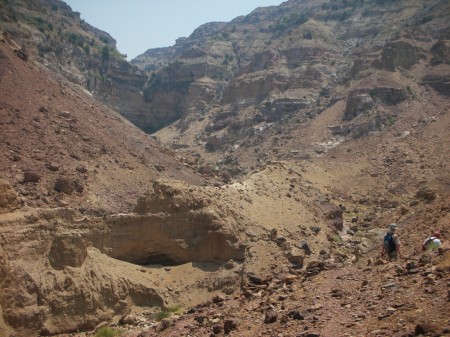
See that tiny shaded valley in the upper left corner? And the even tinier white line if you click to maximize? That's it!
It took another half an hour to cross the baked and shattered plateau and get back into the cooler and shaded streams of the wadi. Interestingly, I noted that most of the rocks around this area were of a pitted and lightweight volcanic variety, and recalled reading that millennia ago, there had been an active volcano in lower Jordan – secular scholars claim that it was responsible for the destruction of the sinful cities of Sodom and Gomorrah of Biblical times, the ruins of which are supposed to be only a few kilometers from where we were now standing. Even more telling were the black rocks that jutted impudently from the regular sandstone. These rocks had the lines of magma flows, and the “popped bubble” surfaces that said they had once been subject to a heat so intense that the stones themselves had bubbled in the heat, only to have those thin stone membranes popped by the elements in the proceeding centuries.
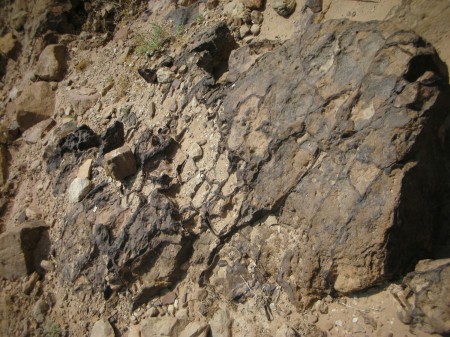
Popped-bubble volcanic rocks trapped in the wadi, which might have been first carved by a volcano, before the water...
Back inside the wadi itself, it was exciting to see the distant waterfall growing ever-closer as we ascended and descended the cliffs, watching it appear and disappear behind the trees and stones. The warm water was clogged with green algae in every side pool, much more than what we had encountered in Hasa. It was obvious that the strength of the sun in these months was the cause. The strong-smelling glop forced us to tread carefully as we climbed trees and rock walls through the wadi; none of us relished the thought of falling into one of those stinking pits.
If the smell was strong, it was matched by the beauty and tranquility of the tallest waterfall in Jordan when we pushed through the last of the oleander bushes to reach the iridescent blue pool at its base. We could barely see the mouth of the fall from here at its base, and the August-thinned gush of water came down and struck the rocks at the base with loud and echoing force. From what I could see of the clearness of the pool before Jeff and Liam rushed across it to reach the fall, it was filled with a grayish, vertical-growing species of algae that hung motionless in the water and looked at first like miniature towers jutting from the bottom. As soon as the silent water at the shore was disturbed by our feet, though, a thick cloud of blue-gray silt and muck rose from the bottom like we were walking through the Nile delta in flood season.
On the far side of the pool, under the waterfall itself, Jeff and Liam had already started inspecting a strange formation that had slowly grown out of centuries of mineral and sand-filled falling water. From a distance it looked like a huge pockmarked piece of pumice, but upon closer inspection, its slick surface was made out of loosely-compressed sand particles that were slowly forming stalactites from the cliff wall towards the pool below. We debated eating the rest of our lunch in the cool depths of the cave that this formation had created, but the small size and the unceasing dripping water forced us to backtrack a few dozen meters back into the wadi to relax under the shade of a huge and ancient palm tree surrounded by oleanders.
On the way out, we traced the water to the top of that first waterfall we had snacked under, which no looked quite tiny in comparison. Because of some ledges blocking our full line of sight, we couldn’t see all the way down to where we had stood a few hours earlier, but Jeff’s GPS told us that it was definitely the correct spot. I could see a new-looking rappelling hook bolted into the stone next to us, and recalled that the wadi book that Nelle had brought with us mentioned that a more adventurous mode of travel than we had used was available for the wadi. As we hiked away from it, the gap in the mountain where it went over the cliff disappeared from us like an optical illusion.
Now the tricky part was getting out. There were some scary moments when climbing out over the cliffs again, namely because it seemed that we were climbing across the disintegrating face of a sand castle. It wasn’t sandstone, just chunks of gravel held together with sand. I could see already that parts of this cliff had fallen to the wadi below, and was happy that there were no apparent hiker bones sticking out of those clumped piles of rubble.
Liam and I naively decided not to follow the wadi guide from this point on, and take a second wadi offshoot back to the car, instead of climbing back down the slippery, shale-covered mountain like we had come up. As we discovered only five minutes later when we followed the dried stream bed to a series of massive waterfalls, there was a reason why the book didn’t mention another way out besides rappelling or climbing over the mountain. However, now we were alone and Jeff and Nelle were no longer to be found. I grinned wryly over at Liam. “Remember, it’s impossible to get lost in a wadi hike – there are only two directions to go.” With that in mind, we climbed up onto the mountain plateau again and headed due west towards the car along the top, instead of dropping back down again beyond the waterfalls.
We actually ended up making it back to the car 50 minutes before Nelle and Jeff, who had left their mobiles behind in the car. I (correctly) figured that Nelle was worried about us, and was hanging back in the foothills waiting for us, even though we had long since passed them by on the easy path along the summit, before dropping down next to the bridge by the highway. With our water exhausted and the car keys with Nelle, Liam and I slumped in the slowly elongating shadow of the rental car and swapped theories on Arabic dialects and accents, and then comparing varieties of British and American accents.
The car was, of course, blisteringly hot when we climbed back inside, but thankfully we were only 10 minutes away from the Dead Sea mini-mart near the hotels that could sell us bottles of ice cold water. I explained apologetically to the tired and thirsty looking shopkeeper why we looked so odd, and we all made sure to duck down low in the car to slurp our precious water, as there was another hour still to go before sunset and the fast breaking.
Wadi ibn Hammad
We had so much fun that we made rapid plans to repeat the hiking experience a week later, this time to the distant Wadi Ibn Hammad in South Jordan, only a little ways off from Karak and its Crusader castle. Although we could have chosen to take one of the city buses to Wadi Himara thanks to its popular location on a major highway, I elected to rent another car for this week, using the company that Nelle recommended to me. After a delicious Ramadan Iftaar feast on Saturday night (the name means ‘opening’ or the breaking of the fast) at the home of my translator, Wamidh, and his wife, I was ready to take everyone south for another hike.
Joanna, returned from summer vacation in America, took Liam’s place in my rented car. Whitman’s first day of school was on Saturday as well, and I was there to check the computers and greet everyone before picking up the car and visiting Wamidh. Together, the four of us sped southward along the familiar Desert Highway, leading towards the familiar borders of Karak. Nelle with her book and memory from a previous visit, guided me from there down poorly marked country roads that led to poor concrete-block homes, then farms, then nothing but steeply descending mountain passes.
The rented Hyundai bumped over the drainage ditch for a lithe little stream at the bottom of the wadi, and I parked next to a squat little concrete building advertising bathrooms and tea. As we unloaded our bags and lunch from the trunk, a slender and dark man with a neatly trimmed goatee emerged from the building’s shadows. Introducing himself as Aqubda, he was obviously unprepared for our Arabic rendition as to why we shouldn’t have to pay 5 JD per person for entry into the Wadi. We’d all lived here for years, the famous Karak castle was only 1 JD, it was Ramadan, the month of Generosity – we laid it all out on him (or at least Nelle and I did). Aqubda gestured helplessly at the entrance tickets in his hand, marked ‘five dinar’ on one side, and ‘واحد دينار’ (one dinar) on the other. He knew we could all read it. He relented eventually and gave us the discounted admission of all of us for 11 JD. From what I’m told, Wadi Mujib – the most famous of Jordan’s water-filled wadis – is charging 16 JD per foreigner these days, so expats living in Jordan should enjoy the remaining unspoiled and free wadis while they can. Ah Jordan – I’m going to miss never paying full price for anything!
Just beyond the building, a flight of crumbling concrete steps led us down into the wadi bed itself, and after a minutes and curves in the deep canyon, the building was lost from view behind curtains of ferns, palm trees, and stones. Ibn Hammad is called by Nelle – and several guidebooks and websites – the “most beautiful” wadi in Jordan, and we were about to find out why.
Only a few minutes in, I was agreeing with Nelle’s assertion that this tropical wadi had to be one of the most beautiful in the country. She smiled and said that we hadn’t even seen the amazing part yet. Thanks to the long car ride, it was already one in the afternoon and we stopped for lunch by the river once we were safely out of offending-range from building. Already, the wadi walls had crept up around us to five or six meters to shadow us, and a large boulder in the creek provided a helpful back rest. As we were eating, I examined the dripping moss and ferns coating the walls, probably never touched by direct sunlight and growing mightily thanks to water oozing out of the stones themselves. I believe the entire area must be honeycombed with hot springs and wells, much more than what we could see in the river next to us. The volume of water rushing past was far greater than anything we had seen in Himara last week.
Not far along the easy path downstream (the small stones and climbs were nothing compared to what we had encountered in Wadi Hasa), we passed into a strange, shaded area and I felt water striking my face. The chance of rain in August was unlikely, so I gazed upwards to see a pockmarked, mineral-encrusted stone ledge extended above us, in such a way that it almost formed an arch from one bank of the canyon to the other. Warm, salty water was streaming gently from somewhere within the monolith, cascading down rough stalactites and ferns to create an unceasing drizzle onto the river below. Nelle still smiled secretively as the other three of us commented on the spectacular sight – there had to be something somehow more lovely further down.
A few minutes more led us to the “tunnel,” a dark crease in the rock of rare golden pillars sunbeams and for a hundred meters, mineral shelves like the early solitary one ruled like grizzled sultans, towering above our heads. The palm trees growing out of the walls above us had soggy bark stained black from years of water exposure, and the air became moist and humid in a way I’ve never before experienced in Jordan. The walls were painted creamy red from quietly burbling jets of water, spitting water rich in iron and thermophilic bacteria which painted sunsets on the stones before mixing and vanishing into the tumult. Everywhere, water dripped onto us from the rocks above, and sometimes in particularly bright cracks in this moist underworld I could catch glimpses of the roots and lower extremities of dusty dry trees growing on the wadi banks 10 meters above our heads.
The roaring in the distance was magnified by this shaped tunnel we journeyed through, but finally we found ourselves on the edge of a small but energetic waterfall, where the colors changed from reds to greens of all hues, encrusting layers of minerals onto the sandstone. I scratched at one with a fingernail, breaking of millimeter-thick layer of this green shellac to expose the damp sand underneath. Above us, mingled with the throaty voice of the waterfall, I could hear faint squeaks and saw dim shadows moving in caves of the shelves – a bat colony, although I never saw one exit.
In my distraction, the other three had already slowly lowered themselves over the rocky edge of the 2.5 meter fall and were waiting for me. I tossed my bag with my camera down to Jeff, and thus unencumbered by weight and electronics, flung myself over the waterfall edge instead, landing in the waist-deep pit carved out by the water’s patient knife. The others were already ahead, playing with a cold sprinkle coming from one of the shelves, laughing and dodging as they tried to catch the cool drops on their faces.
In another five minutes, the wadi began to widen again and brighten, and we emerged from the humid tunnel back into the regular wadi. Glancing at my watch, I couldn’t believe we’d only been in that incredible place for 20 minutes from end to end! Squinting into the new sunlight, we continued along a few last bends in the canyon before we exited the deep wadi, finding ourselves on a wide delta with the river, now small-looking compared to this openness, continuing on through the underbrush of oleanders and bamboo.
It had only been two hours since we started our journey, and Nelle told us that when she had come last year, they’d turned back soon after this point to head back up the trail. However, Walkingjordan.com had told me that there was a waterfall worth seeing another kilometer downstream, so with my encouragement, we continued, sticking close to the high left wall’s shade. It wasn’t long afterward that we came across almost a dozen thick black pipes snaking their way over the high wall and coming down to drink greedily from the stream. The Bedouin farmers who had presumably brought them in had rigged up ingenious wire and rope systems to hold them in place, and it had apparently worked because some of the pipes looked positively ancient, faded to almost white and caked over with years of seasonable algae grime. Regardless of the pipe’s age, each one of them was punctured in many places, sending gouts and streamers dancing into the air like a child’s sprinkler toy. All around us they hissed and gurgled, sounding for all the world like real snakes instead of lookalikes, and finally around one corner their bulks vanished over the hill again and we were left alone with the river again.
We weren’t entirely alone, unfortunately. Jeff suddenly gave a shout of surprise, and as we crowded around him, he hurriedly yanked off his shoe and sock, taking with them a writhing gray segmented worm that he told us had apparently bit him a moment earlier. Sure enough, a small red mark was rising up from his ankle, and we all anxiously checked our own feet, ankles, and calves for unwanted passengers. I horrified my companions by describing some of my mother’s animal patients; dogs that have had parasites gnaw pockets under the fur and skin to create an abscess-cocoon. It definitely wasn’t a leech, but a parasitic worm that could burrow into your skin was much more probable – and worrisome. Leeches sounded great by comparison; I mean, they couldn’t be that bad if they had been used by doctors for centuries!
After another half hour of walking – now avoiding the water a little bit more, after Jeff’s worm removal – we came to the waterfall, set among huge bleached white stones that were too large to climb down anywhere but a dozen meters beyond the waterfall, requiring us to double back to reach the falls. While not even in the same league as the two behemoths we had seen in Himara last week, the volume of water was many times greater. Like inside the tropical tunnel earlier in the day, the rocks around us created and echoing chamber that made the roar of the falls almost deafening. We took turns braving a short and slippery climb to a rock outcropping inside the waterfall, listening to our voices broken and refracted by the tons of water crashing around us so that it sounded like we were speaking through an oscillating fan. It was easy to leave the perch: a quick slip forward and the water rocketed me out of the ledge on the soaked algae to land with a semi-painful splash a good four meters away. I winced, got up, and felt a sudden sharp pain in my ankle. For one agonized moment I thought it was broken, then glanced down and grimly pulled off the gray worm that was tightly attached to my skin.
It was time to head back out and back home. After being thoroughly and relaxingly pounded by the crashing waterfall to our hearts’ content, we quickly ventured back across the pipes, the wide delta, and back into the wadi and the tunnel. The sun had begun to set by this time, and the wadi was pleasantly cool and the colors were muted by the coming darkness. After reaching the other end of the tunnel, Jeff motioned back to us that men were coming down the path. Nelle and Joanna fretted a little bit about the fact that they were wearing somewhat revealing clothing – we didn’t expect to see any Arabs here in Ramadan – but surprisingly enough, the dark skinned group had a woman. Then we saw why – the last man in the group was wearing a yarmulke skullcap on his head. It was a Jewish travel group! More and more, it was obvious to me why the Fidel Castro lookalike in Wadi Hasa had casually asked me if we were Israelis – they love to come over to this side of the border and hike. Nelle’s travel book is written by an Israeli, in fact.
Back at the parking lot, the now-shirtless Aqubda was waiting for us with a smile and a pot of sugary black tea. You’re not fasting for Ramadan? I asked him, and he gave me a look like I was a little slow and said “in this heat? Do you think I want to die out here?” He explained that he and a fellow Karaki partner took 4-day/night shifts out here to guard the place. He liked the work, but it was boring – especially in Ramadan. He was very happy to chat with us for fifteen minutes! As the five us sat drinking our tea around a beat up card table at the edge of the wadi, a vanload of young men pulled up. Aqubda told us his friends had come from Karak to have iftaar with him – even though technically there was nothing to ‘break’ in his case!
The cool night air on the drive back to Amman was aided only slightly by the old car’s air conditioning, and we were all still so energized and excited from the trip that no one napped (not even me, the driver!) and we just chatted about friends and family back in America. I still had the car for another day, until mid-afternoon, so I suggested that if anyone wanted to join me for a last trip to the Dead Sea, we should do that tomorrow morning.
———
That was almost a week ago now, and my skin has still not recovered from the drubbing it received from the sun. I’m sitting at Whitman now, putting the finishing touches on this post, and whenever I shift or shuffle in my chair in front of this lab computer I’m running tests on, I feel like my skin is crackling like seared bacon on a grill. And now I’ve gone and made myself hungry. It’s tough to get these blog posts out in time when you don’t have internet at home anymore – it’s been gone for almost a month now – but Wajih told me yesterday that he’ll let me borrow his 3G cell modem USB device until I return to America in a week.
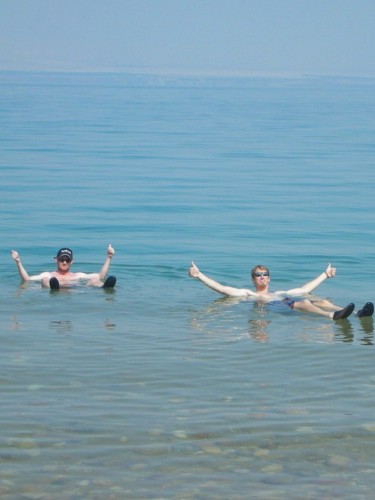
Jeff and I floating along. Those shoes I'm wearing, like my back, were totally destroyed from the excursion
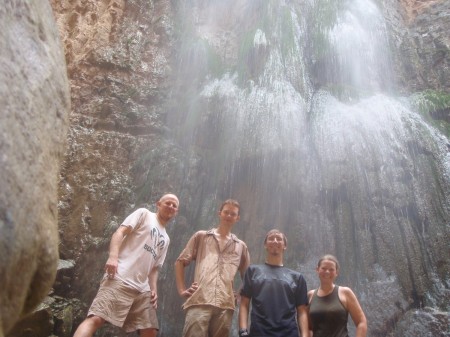
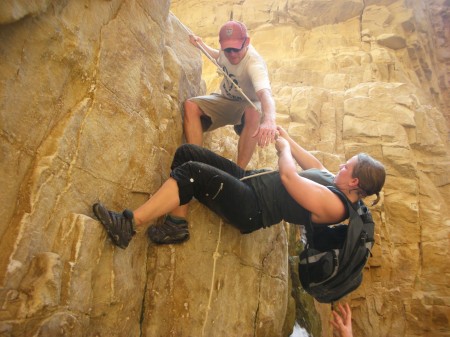

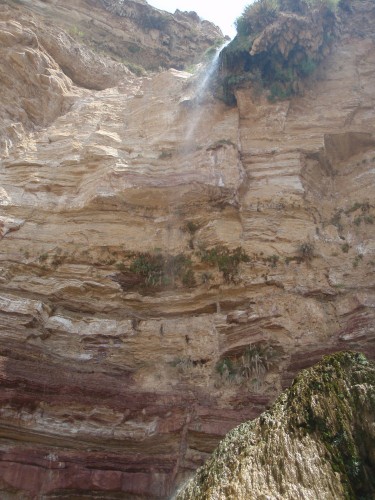
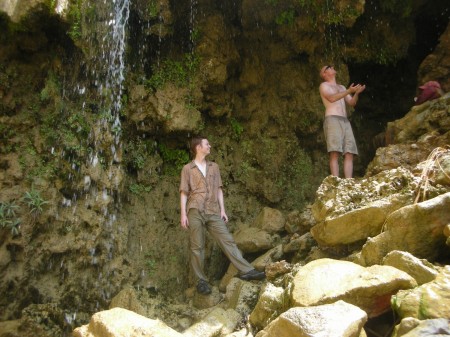
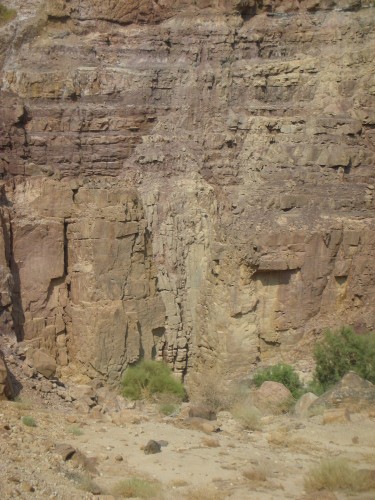
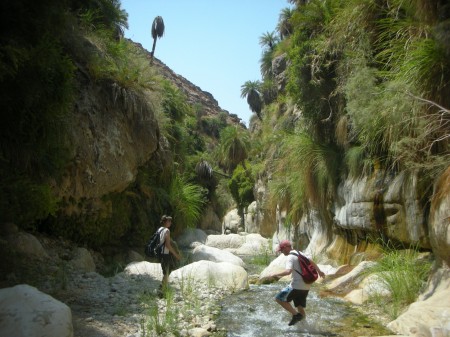
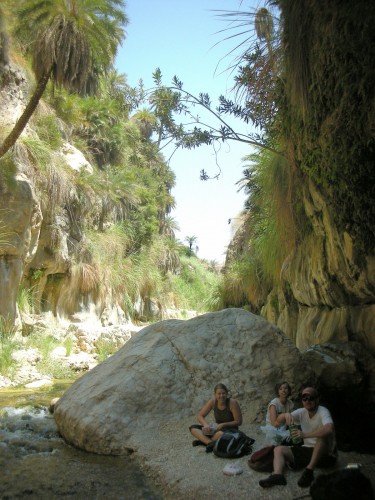
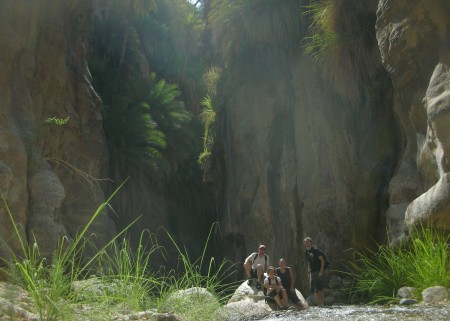
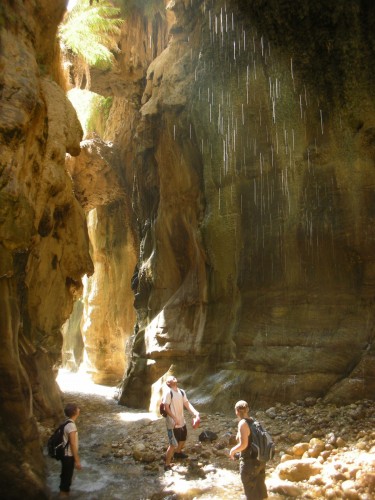
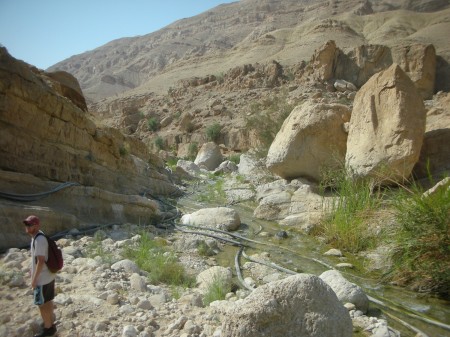
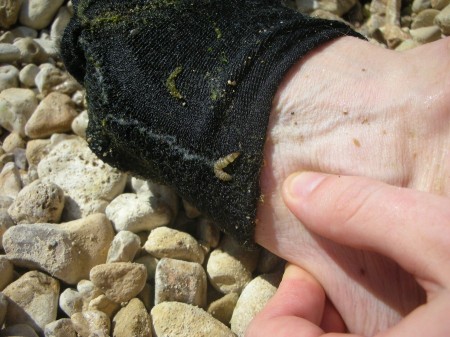


What’s up, just wanted to say, I enjoyed this post. It was helpful.
Keep on posting!